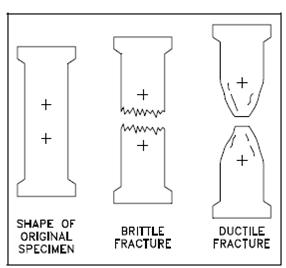Basic Fracture Types:
Brittle cleavage fracture is of the mainly concern in this module. This occurs in materials along with a high strain-hardening rate and associatively low cleavage strength or great sensitivity to multi-axial stress.

Figure: Basic Fracture Types
Several metals which are ductile under a few conditions become brittle if the conditions are altered. An effect of temperature on the nature of the fracture is of considerable importance. Several steels exhibit ductile fracture at elevated temperatures and brittle fracture at low temperatures. A temperature above that a material is ductile and below that it is brittle is known as the Nil-Ductility Transition (NDT) temperature. That temperature is not precise, other than varies according to prior mechanical and heat treatment and the nature and amounts of impurity elements. It is determined through a few form of drop-weight test (for instance, the Charpy or Izod tests).
Ductility is an necessary needed for steels used in the construction of reactor vessels; thus, the NDT temperature is of importance in the operation of these vessels. A little grain size tends to increase ductility and results in a decrease in NDT temperature. Grain size is controlled through heat treatment within the manufacturing and specifications of reactor vessels. A NDT temperature could also be lowered through small additions of chosen alloying components like as nickel and manganese to low-carbon steels.
Of particular importance is the shifting of the NDT temperature to the right that was display in the above figure, while the reactor vessel is exposed to fast neutrons. The reactor vessel is always exposed to fast neutrons which escape from the core. As a result, during operation the reactor vessel is subjected to a raising fluence (flux) of fast neutrons, and as an output the NDT temperature increases steadily. That is not likely that the NDT temperature will approach the normal operating temperature of the steel. Therefore, there is a possibility that when the reactor is being shut down or during an abnormal cooldown, the temperature might fall below the NDT value although the internal pressure is still high. The reactor vessel is susceptible to brittle fracture at this point. Thus, special attention must be provided to the effect of neutron irradiation on the NDT temperature of the steels used in fabricating reactor pressure vessels. A Nuclear Regulatory Commission needs in which a reactor vessel material surveillance program be conducted in water- cooled power reactors in accordance along with ASTM Standards (designation E 185-73).
Pressure vessels are also subject to cyclic stress. A Cyclic stress arises from pressure and/or temperature cycles on the metal. Cyclic stress could lead to fatigue failure. Fatigue failure, elaborate in more detail in Module, could be initiated through microscopic cracks and notches and even through grinding and machining marks on the surface. The similar (or same) defects also favor brittle fracture.